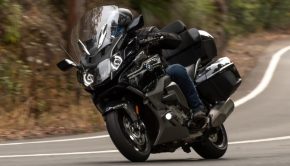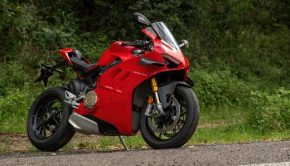INDIAN – THE RESURRECTION

The Classic, the Chieftain and the Vintage
Understand this.
In April of 2011, Polaris Industries announced its intention to acquire Indian Motorcycles, then owned by a London-based private equity firm called Stellican, which was pretending to make motorcycles in Kings Mountain, North Carolina.
But it wasn’t. Not really.
In September 2013, I am standing in front of a resort called Peppers, at Kingscliff, a few kilometres south of the Queensland border, and gazing at three new, different, and completely homologated Indian motorcycles.
All of which I am about to ride.
Pretty neat, huh?
No, not the bit about me at the resort.
The bit about Indian making a complete bike in less than three years.
The night before, a selection of the Australian motorcycle press corps had been herded into a room and shown the three models of new Indian, and given a fascinating presentation by the company.
I took notes.

Do note the ground clearance, which is very evident in this image
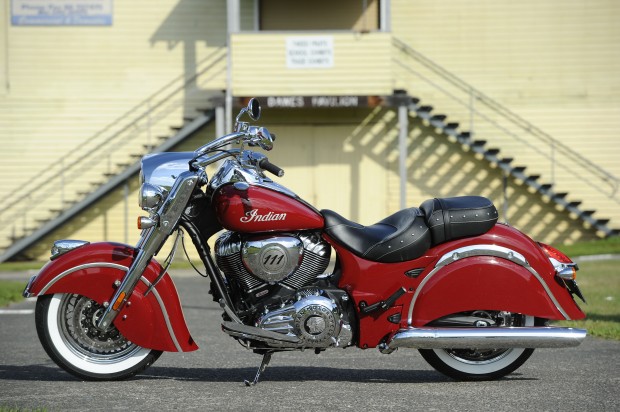
Yeah, there’s many happy hours of waxing here
And I never take fucken notes at these things.
But I took notes at this because I was very excited and because I understood what an important historic milestone this was.
Indian is a name that predates Harley-Davidson by two years.
It is a marque redolent with history and gravitas.
The Hendee Manufacturing Company started the Indian Motocycle (note the spelling) Company, and in 1902 the first Indian motorcycle was sold to the public.
In 1903, Indian set the motorcycle land speed record of 56 mph.
In 1911, Indian took the first three places at the Isle of Man TT and Indian factory rider Jake DeRosier set speed records in Brooklands, and in the US, and won more than 900 dirt and board-track races.

Fringes never stopped being cool. You stopped being cool.

The feel and quality is simply sensational
A few years later, Indian was the biggest motorcycle manufacturer in the world.
As such, it felt it was incumbent upon it to support the US war effort during the Great War.
And this was the beginning of the end for Indian – much like it was for the British Empire, the Ottoman Empire and the Austro-Hungarian Empire.
Indian supplied so many of its engines to the US government it was unable to service its own dealers.
After the war, Indian was playing second fiddle to Harley-Davidson and despite the boom of the Twenties, it merged with DuPont Motors in 1930, and following a series of unfortunate corporate events, a worldwide depression, another world war, and a series of woeful exploding motorcycles, Indian went belly up in 1953.
Some mental shit went down 1957 when a mob called Brockhouse Engineering acquired the name and set about importing Royal Enfield bikes from England, re-badging and selling them as Indians.
But there was no more Indian.
Various people made various attempts at resurrecting the name, and building an actual bike, but everyone went broke or mad and nothing really happened until Polaris came along.
And then, in two short years, everything happened.

Indian’s first-ever bagger
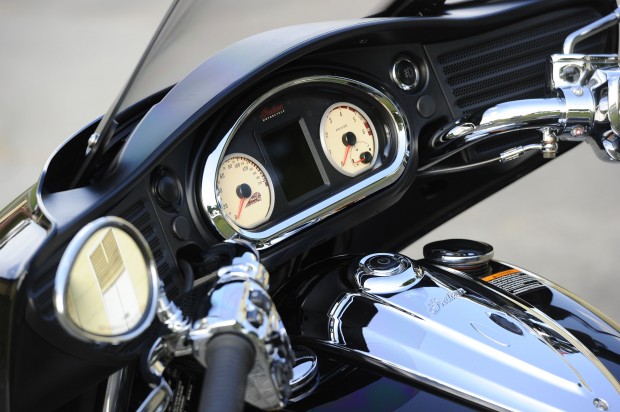
Classic styling with cutting-edge technology
And here it was.
And I was sitting on it.
I was even making broom-broom noises, but I was doing that to myself so the Indian people would not freak out.
It had a brown, fringed leather seat, a very tough-looking 111-cubic-inch motor and it had ‘Indian’ written on every conceivable surface.
Part of me was wondering how many American-Indian clichés would sprout from the fingertips of my colleagues, and I realised it would be too many to count. I resolved not to include a single one in my report.

Great lines… the bike isn’t bad either.
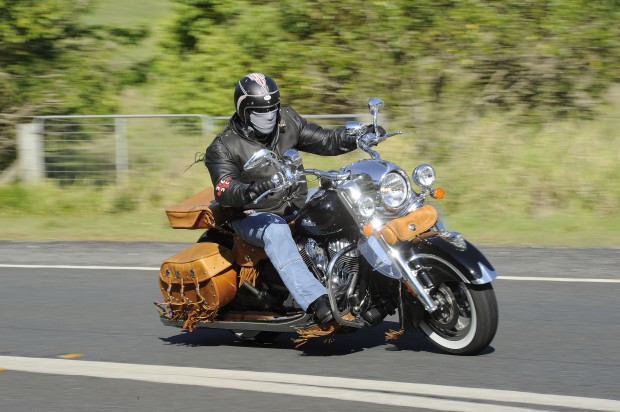
Look out, Queensland government, the tassles are coming for you.
Another part of me realised just how much was at stake here for Indian.
Either these unique-looking motorcycle were the real deal, in that they worked properly, and brought fresh technology and innovation to the tired old cruiser table, or they were rubbish.
Stylistically, they are a success. You will not mistake an Indian for any other brand. The valanced fenders are pure Springfield, Massachusetts circa 1940 and that magnificent-looking 49-degree V-twin is all its own, hearkening back to the original finned rocker-boxes and downward-exiting pipes of the early models. The war-bonnet is also ubiquitous and sits proudly on the front mudguard, glaring at the road through its LED-bright war-face.

This is Gary Gray, the engineer responsible for creating the Indian
I was to ride three models, the Classic, the Vintage and the Chieftain, which was Indian’s first-ever bagger. All of them pulse with the 160Nm (Oh, yes. One hundred and sixty is not a misprint) of torque, boast keyless ignition, cruise control, genuine leather seats (made by the very same folks who used to make them for the original Indian factory in 1901) and the free world’s chrome-production as standard.
The differences between the models are significant.
The Vintage comes with a screen, which can be removed (or fitted) in literally seconds, and the iconic brown leather seat and saddlebags. These are standard. You want black (presumably because you are some kind of whining bitch), you’re gonna have to buy it as an extra. Don’t. People will know you’re soft and weak. The natural leather actually works when you see it in the flesh. And it is so luscious I would wear it and maybe do unspeakable things to it…

Think of how much Dubbin you could rub into that. In candelight. With soft music in the background…
The Chieftain offers up a top-end 100-watt sound system (that can be optioned up to 200-watts) that is Bluetooth compatible and a powered windscreen so that you can actually hear it at highway speeds. The Chieftain also steers a little quicker thanks to a steeper rake – 25 degrees as opposed to the Classic’s and Vintage’s 29 degrees, giving it a slightly shorter wheelbase and the ability to carry a touring load with better weight distribution.
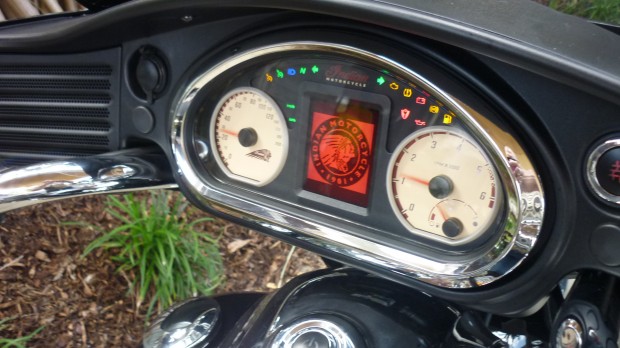
The helm of the Chieftain
As my fellow journos and I wended our way out of the resort and onto the highway, I was immediately taken with the sheer grandeur of the rider’s point-of-view. The massive front nacelle, complete with a crested shark’s fin sits high and radiates nothing less than awesome mightiness as you behold it from behind. You tend to sit ‘in’ the Indian, and while you can get a range of differing seats to deal with your physical inadequacies (short legs, large belly, dwarf-like arms) that will sit you closer and higher, the standard ergos are perfect for men of my size.
The road-presence of all three is titanic – and the big girls carry their weight low and with immense grace and ease. Low-speed urban weaving is a doddle and the bikes are surprisingly agile.

The blue matches my eyes
But what sat me up and made me blink and make eeping noises was the suspension. Indian has nailed it. Its factory-tuned Kyabas up front and Fox on the rear (boasting 150mm of travel and adjustable for preload), are just great. No other cruiser can boast that much rear-suspension travel. So Indian can rightly claim to be the best-suspensioned cruiser on the road today.
I traversed some dire bumpy rubbish coming into and out of Nimbin, and then back to the coast around the base of Mount Warning on the Kyogle Road through Uki and the normal arse-slam-pray-and-steer was just not there.
Can I tell you how much less-tiring a big cruiser is to ride when its suspension has not surrendered like a Frenchman?

In basic black
The bikes were all geared rather tall, and I was struggling to get a fair turn of speed up thanks to the lead rider being all conservative and safe and probably under strict instructions not to let those vile journo bastards start their normal pissing contest.
But I found that if I hung back a bit, I was able to find meaningful velocity and discover what was what when you threw the bike into a bend with some anger. Firstly, the ground clearance was excellent. Sure, you could touch down the footboards and murder some of the optional-extra footboard tassles, but if you were doing that, then you were seriously punting along. At respectable speeds, all was sweetness, light and stability.

LED technology is everywhere

The war bonnet
The brakes were well-matched to the package. The ABS-enabled twin-caliper discs up front were most effective in returning sanity to some of the more spirited corner entries I managed. Good feel on the brakes along with adequate power is great on a big bike, and the Indian’s stoppers were top-notch.
If you’re interested in getting your mongrel on, I would advise utilising that lovely little six-speed constant-mesh helical gearbox with verve. It shifts very smoothly and positively and you are rewarded in your speed-seeking efforts when engaging the lower gears as much as possible. Of course, if you just want to admire the scenery, leave in top. All those newton-metres are happy to please.
Indian also spent a lot of time and effort making sure that motor wasn’t going to bake your right leg into crackling on a summer run. We were blessed with a 37-degree day for our ride, and everyone was impressed with how the heat-management worked. Indian have ceramically-coated the headers and created dual-layered valve covers; combined with a massive amount of finning. This make it one of the coolest V-twins on the road as far as your right leg is concerned.

The dual valve-cover that is designed to shift heat. It works, too.
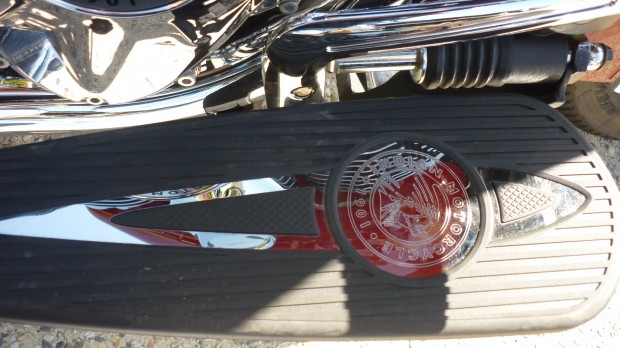
The logo is everywhere

Even on the conchos
The question everyone wants answered is how does it compare to the Harley?
I cannot answer that. I did not ride one back-to-back with a new 2014 Harley. But I will.
But consider this…
Harley has had no real competition since Indian went bust just after World War II. Sure, Victory came along a few years ago (Victory is also owned by Polaris, but shares nothing mechanically or technically with Indian other than the parent company and possibly some accountants), but while it could lay honest claim to being an American motorcycle, Harley’s heritage trumped it in the marketing stakes. Victory builds great bikes – powerful, modern-looking cruisers that handle well and tour with ease, and you would have to seriously consider one if you were in the market for a big V-twin. But a Harley is a Harley is a Harley. It does what it does very well, and I understand it’s 2014 range is better than ever. But it is the name and the history behind it that drives its sales as much as anything else. Victory could never compete with that.

Yes, it was this romantic
But Indian can. Its history is every bit as glorious and two years older than Milwaukee’s. It can boast a vast range of world-firsts when it comes to motorcycle development and innovation. So there is a rich vein of heritage to market. The Indian name resonates very strongly among motorcyclists, especially within the key buying demographic.
But the key to Indian’s success was always going to be in the product it produced when it came to putting its money where its heritage was. Your name, no matter its glory, is really worth nothing if you ultimately produce a bike that does not immediately captivate the rider.
In this Indian has succeeded. And succeeded magnificently. It has built a bike that is not only rivals its competition, but it exceeds it in some key areas.

The face of the Classic
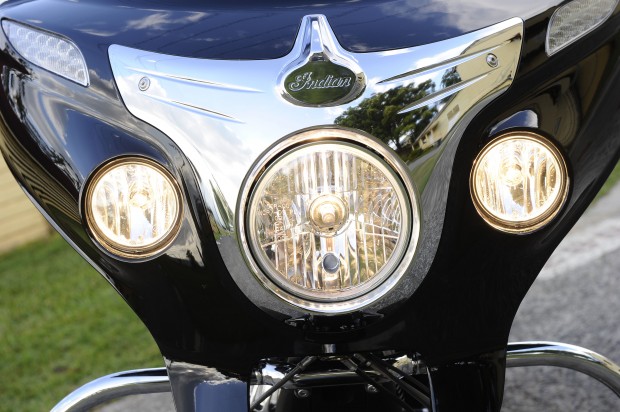
The Chieftain’s grin
Is it better than a Harley is some areas? Yes, it is. The engine is refined, smooth, powerful and handsome. The exhaust note is stunning. The gearbox is excellent and the suspension is the best in its class. It is certainly a worthy competitor for Harley.
And that is the best thing that has happened for the motorcyclist in ages.
Just as we have seen the Japanese manufacturers leap-frogging one another in innovation and technology, we shall once again see Harley and Indian doing the same thing. And such fierce competition between two American motorcycle manufacturers has not been seen since the first quarter of this century. And we, the riders, will be the ones who will be winning as a result.

You do know that Indians were once officially blue, yes?
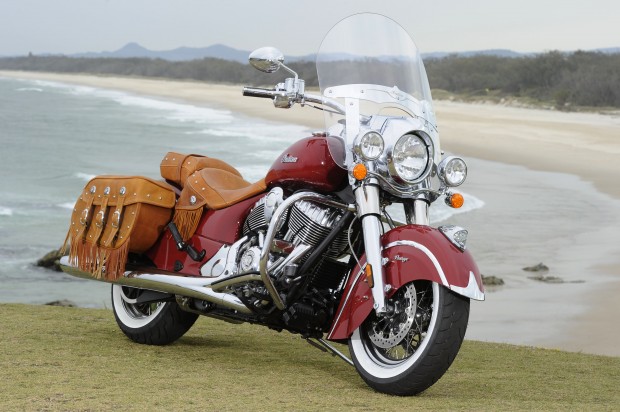
The Vintage be-fringed
I do not know what Indian has in store. The engineer who designed the bike, Gary Gray, would not be drawn on what was coming. No matter how many whiskeys I tried to force upon him after the ride.
There was not a single member of the press who was not immensely impressed with what was offered to us during two great days of riding.
And while I cannot predict the future, what I do know is this:
Indian is here. Indian is back. Indian is serious.
And Indian is brilliant.
I WAS THUNDERSTRUCK
There are 111 of mighty cubic-inch bastards inside that tough-looking lump of an engine, which has been totally designed from the ground up, and is certain to occupy a prominent place in the great hall were awesome V-twin motors are worshipped. The first thing you notice when firing it up is just how quiet the engine actually is. It is completely balanced and the crank is directly connected to the shaft, so what you’re going to hear is what you want to hear, and that’s the exhaust note. I have never heard another V-twin like it, especially when it begins to sing through the optional Stage One fishtail exhausts. It literally booms and thunders a deep basso-profundo note that is uniquely its own.
The torque numbers are drool-worthy – every one of the 160Nm does its very best to literally fire you down the road via a true Fly-By-Wire throttle with no noticeable lag. It’s a very compact engine and the 5.2litre oil-tank is housed within the engine cases. It’s a semi-dry sump and sues a clever scavenging system to lube its angry bits up.
The factory promises low-maintenance and long 12,000km drinks between services. And to my amazement, Indian, understanding that what it sounded like was crucial, actually employed a sound-engineer to make sure the whole package sounded…well, ‘right’. The bloke actually made musical thirds and fifths out of the helical gears! The end result is a powerful, quiet, very tractable and willing motor that sounds simply amazing.

There is much happiness inside there.



